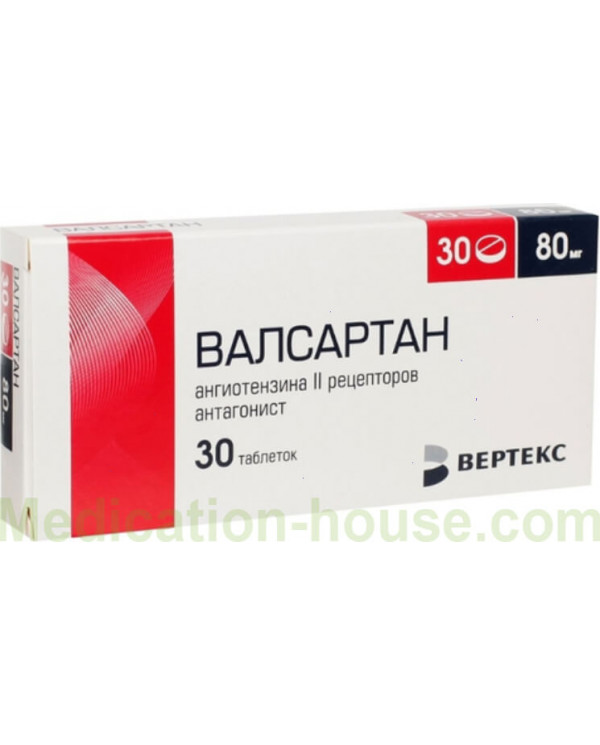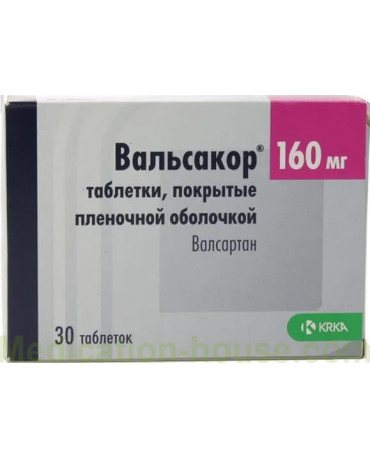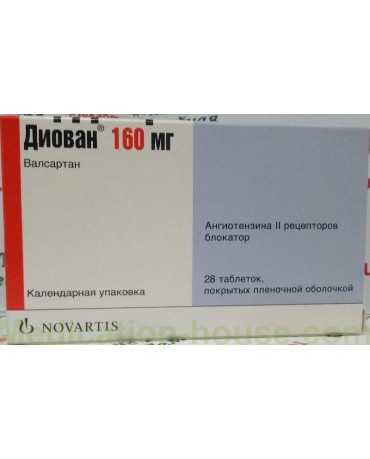Instruction for Valsartan
Reed more and buy Valsartan here
Detailed composition and dosage form
Valsartan has a positive effect on the state of the cardiovascular system, due to the content of the active substance - valsartan.
The product is produced in three varieties. All subspecies are available in tablet form, but contain different amounts of active ingredients: 0.04 g, 0.08 g, 0.16 g each.
In addition to the active component, when creating tablets, auxiliary chemical compounds are used that are common to all varieties. In the manufacture of Valsartan are used:
Microcrystalline cellulose;
Croscarmellose sodium;
Aerosil;
Magnesium stearic acid.
The tablets are film-coated, consisting of:
PVA;
Polyethylene glycol-3350;
Dyes in the form of iron oxide red and yellow, titanium dioxide;
Talcum powder.
For each variety, the required amount of auxiliary components is used to impart the desired physical characteristics.
The surface of the rounded, biconvex tablets is pink. On pills containing 0.04 g and 0.08 g of the active ingredient, there is a horizontal risk in the middle.
Tablets are packed in PVC and aluminum concurrency with individual contour cells. One blister contains 7, 10, 14, 20, 28, 30 or 56 units of medicine. A cardboard box can contain from 1 to 6, as well as 8 or 10 convalutes and official instructions for use.
Valsartan is dispensed from pharmacies after presentation of a prescription from a specialist. Recommendations for use are determined by the attending physician.
Pharmacological possibilities
Valsartan is used as an active ingredient in the composition of the drug, which, by binding to receptors sensitive to angiotensin, violates the pressor effect of the renin-angiotensin-aldosterone system.
Valsartan receives antihypertensive properties by forming a relationship with angiotensin-1 receptors. The result of this interaction is an increase in the amount of free angiotensin-II circulating in the bloodstream, which is able to affect unused AT-2 receptors.
The lack of influence on the angiotensin-converting enzyme involved in the dehydration of bradykinin helps to avoid unwanted reactions associated with the respiratory system (cough, etc.).
The agent does not affect other receptor systems and ion channels involved in the regulation of cardiac activity.
Therapy with Valsartan allows you to lower blood pressure without causing a simultaneous change in the number of heart beats per minute.
With oral single use of the drug, the occurrence of a therapeutic effect is recorded in a two-hour interval of time, and the most pronounced results are observed 240-360 minutes after taking the tablets. The duration of the antihypertensive effect persists over a 24-hour period.
Long-term therapy, involving regular intake of the drug, shows stable results after 14-28 days from the start. Combined treatment with hydrochlorothiazide leads to more pronounced results. Abrupt withdrawal of the drug does not cause severe hypertension and other side effects.
In case of heart failure, which has a chronic course, the agent reduces the negative increased effect of the renin-angiotensin-aldosterone apparatus, which is the main mechanism for eliminating symptoms.
These effects help to reduce the preload on the heart muscle, increased capillary pressure in the lungs, pressure during diastole in the pulmonary arteries, and increase the force of cardiac output.
The agent is rapidly absorbed from the gastrointestinal tract, but the level of absorption varies significantly from patient to patient. The average absolute bioavailability is 23%. The maximum amount of the active substance is recorded in the bloodstream after 120 minutes, and the most pronounced hypotensive effect is noted after a month of therapy.
The pharmacokinetics of the drug does not depend on gender. The agent in a high degree (up to 97%) binds to plasma proteins.
About 20% of the accepted amount is metabolized in the liver to pharmacologically inactive metabolites.
With the help of the urinary system, about 13% of the drug is excreted, and up to 83% by the intestines. Half-dose elimination time is 6 hours.
The effectiveness of the drug does not depend on the diet, although immediately after a meal, the concentration of the drug over a period of time decreases by almost half.
Pharmacokinetics in CHF patients is similar to that in healthy people.
There may be a slight increase in the bioavailability of the drug in patients over 65 years of age.
Renal pathologies do not affect the pharmacokinetics of the drug according to the results of studies in patients with mild, moderate and severe impairments. Studies in patients with creatinine clearance less than 10 ml per minute have not been conducted.
With pathological changes in the hepatic functions of mild and moderate severity, an increase in the total concentration of the drug in the blood during the observation period is 2 times compared with healthy people.
Indications for use
Valsartan is recommended to combat long-term and persistent increase in blood pressure and heart failure with a chronic course, as well as to reduce mortality as a result of myocardial infarction. In the international classification of diseases (ICD-10), these conditions are under codes I10, I15, I21, I50.0.
Method of administration and dosage
The daily dose of the medication depends on the indications. Valsartan is taken whole, regardless of the diet.
When treating high blood pressure, it is recommended to start taking it with 0.08 g per day, once a day, continuously for a long time. Race, gender and age do not affect the dosage regimen. In the absence of the expected effect within 2-4 weeks, it is possible to gradually increase the dosage to the maximum allowed amount - 0.32 g per day or to prescribe diuretic medications in parallel.
With insufficient functional indicators of the heart, characterized by a chronic course, therapy should be started with 0.04 g twice a day, daily. Increasing the dose in the absence of the expected effect should be carried out every 14 days to 0.08 g, 0.16 g or 0.32 g (maximum daily dose) until results appear.
After a heart attack, to reduce the likelihood of lethal consequences, the first dose of Valsartan should be taken within 12 hours after the illness. The initial dosage is 0.02 g twice a day. Perhaps a gradual increase in the dose to 160 mg twice a day for several weeks. The maximum allowable amount of medication is 0.32 g, divided into two doses.
The most acceptable is to increase the dosage to 80 mg twice a day by the 14th day of treatment, and up to the maximum by the end of the three-month period of therapy.
If an undesirable reaction occurs in the form of severe hypotension or abnormalities in the work of the kidneys, a dose adjustment downward is necessary.
For each of the diseases, it is possible to use Valsartan in mono- or combination therapy.
Use in special categories of patients
Elderly people, as well as patients with impaired renal function with creatinine clearance above 10 ml per minute, do not need to change the dosage regimen.
Patients with mild and moderate liver pathologies, not complicated by cholestasis and not associated with biliary genesis, can use no more than 80 mg of the drug per day.
Valsartan is not used in pediatrics due to the lack of evidence of the safety and effectiveness of the drug for children and adolescents.
Contraindications
Medical contraindications for the use of the drug are the conditions presented:
Individual intolerance to the components;
Planning pregnancy, its presence or lactation period;
Childhood and adolescence;
Treatment with aliskiren for diabetes mellitus;
Cirrhosis of biliary origin, cholestasis;
Severe violations in the liver.
Valsartan requires careful use by patients with:
Severe cardiac insufficiency (grade 2-4);
Bilateral renal artery stenosis;
Clearance of creatinine less than 10 ml per day (including in hemodialysis);
Ischemic heart disease;
Cerebrovascular pathologies;
Kidney transplants;
Decreased circulating blood volume;
Increased secretion of aldosterone;
Hepatic pathologies of mild to moderate severity, not associated with biliary genesis and uncomplicated cholestasis;
Stenosis of the valves of the heart and aorta;
Hypertrophy of the walls of the ventricles of the heart.
Do not carry out joint therapy with other drugs that suppress the activity of the renin-angiotensin-aldosterone system and angiotensin-converting enzyme inhibitors.
Side effects
The instructions contain a warning that Valsartan can cause the development of the following side effects:
Anemia, neutro-, thrombocytopenia;
Vertigo;
Cough, pharyngitis, laryngitis;
Respiratory and viral infections;
Dizziness, insomnia, syncope, headache, skin sensitivity disorders, headache, photophobia;
Severe hypotension, arrhythmias, worsening symptoms of CHF;
Diarrhea, nausea, vomiting, loss of appetite, constipation, abdominal pain, cholestasis;
Rashes, itching, angioedema, vasculitis, urticaria;
Hyperkalemia, hyperbilirubinemia, hypercreatininemia, hyperuricemia;
Muscle pain, joint pain, soreness in the back, rhabdomyolysis;
Disorders in the work of the kidneys, including acute functional pathologies;
Serum sickness;
Fatigue, edema, erectile dysfunction.
If any adverse reactions occur, you should consult your doctor for further advice.
Overdose
Valsartan, when used at a dose significantly higher than the recommended one, can cause the development of:
Severe hypotension;
Dizziness and weakness;
Nausea, vomiting;
Oppression of consciousness;
Collapse;
Shock.
There is no specific treatment.
Pregnancy and lactation period
Treatment with Valsartan during gestation is prohibited due to the risk of developing intrauterine pathologies in the fetus, as well as hypotension and jaundice in newborns.
It is not known if the substance can pass into breast milk. During medication therapy, breastfeeding must be stopped.
Drug interactions
Valsartan together with lithium-containing drugs leads to an increase in the amount of lithium in the bloodstream, as well as to the risk of toxic effects, which makes concurrent administration of these funds undesirable.
In patients of older age groups with a reduced volume of circulating blood or abnormalities in renal function, Valsartan, together with non-steroidal anti-inflammatory drugs, increases the risk of acute renal failure and a decrease in the hypotensive effect.
Parallel administration of the drug with drugs that inhibit the activity of the angiotensin-converting enzyme, aliskiren, or other AT-1-receptor blocking agents increases the likelihood of hypotension, impairment of renal function and hyperkalemia.
Concomitant use of cyclosporine, rifampicin, ritonavir may increase systemic exposure of the drug.
Potassium-sparing diuretics and potassium-containing products increase the likelihood of hyperkalemia.
Use caution when performing potentially hazardous activities due to the risk of dizziness and fatigue.
Storage conditions
The instruction recommends limiting the access of children to the medication, and keeping it in a dry, dark place with a temperature below 25C. Use within 3 years.
Terms of sell
You don't need a prescription to buy Valsartan.



